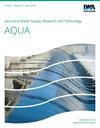尼泊尔东部Kankai河流域Siwalik地区地下水潜力分区
IF 4.3
Q2 Environmental Science
引用次数: 0
摘要
全球地下水资源在数量和质量上都在不断退化,正确的评价和管理对地下水资源的可持续利用至关重要。本研究旨在利用地理信息系统(GIS)和层次分析法(AHP)的综合方法,在尼泊尔东部Kankai河流域的Siwalik地区划定地下水潜力区。对水文地貌、土地利用/土地覆被、岩性、坡度、地形湿度指数、排水密度、归一化植被指数、地貌密度、坡向等不同主题层进行了制作和处理,并在Saaty标度上设置了合适的权重。圈定的研究区地下水潜力区分为低、中、高3个等级。结果表明:研究区地下水低潜力区约占研究区总面积的49.38% (130.85 km2);中等电位区约占总面积的35.5% (94.07 km2),高电位区仅占总面积的15.05% (39.88 km2)。利用该地区泉水的空间分布,对潜力图进行了验证,预测率为70.6%。分析表明,水文地貌、LULC和岩性对地下水赋存有重要的控制作用。该研究表明,地下水资源的稀缺性,需要更好的管理计划和可持续利用战略。本文章由计算机程序翻译,如有差异,请以英文原文为准。
Groundwater potential zonation in the Siwalik of the Kankai River Basin, Eastern Nepal
For the globally degrading groundwater resources in terms of quantity and quality, proper assessment and management become crucial for their sustainable use. This study aims to delineate the groundwater potential zones using an integrated approach of geographic information system (GIS) and the Analytical Hierarchy Process (AHP) in the Siwalik of the Kankai River Basin, Eastern Nepal. Different thematic layers like hydrogeomorphology, land use/land cover, lithology, slope, topographic wetness index, drainage density, normalized difference vegetation index, lineament density, and aspect were prepared and processed with suitable weights on Saaty's scale. The delineated groundwater potential zones in the study area were categorized as low, moderate, and high. The results showed that approximately 49.38% (130.85 km2) of the total study area has a low potential for groundwater. The moderate zone includes approximately 35.5% (94.07 km2) and the high potential zone includes only 15.05% (39.88 km2) of the area. The potential map was validated with a 70.6% prediction rate using the spatial distribution of the springs in the area. The analysis shows that hydrogeomorphology, LULC, and lithology have a significant control on the occurrences of groundwater. The study signifies the scarcity of groundwater resources, which needs a better management plan and strategies for sustainable use.
求助全文
通过发布文献求助,成功后即可免费获取论文全文。
去求助
来源期刊
CiteScore
4.70
自引率
0.00%
发文量
74
审稿时长
4.5 months
期刊介绍:
Journal of Water Supply: Research and Technology - Aqua publishes peer-reviewed scientific & technical, review, and practical/ operational papers dealing with research and development in water supply technology and management, including economics, training and public relations on a national and international level.

 求助内容:
求助内容: 应助结果提醒方式:
应助结果提醒方式:


